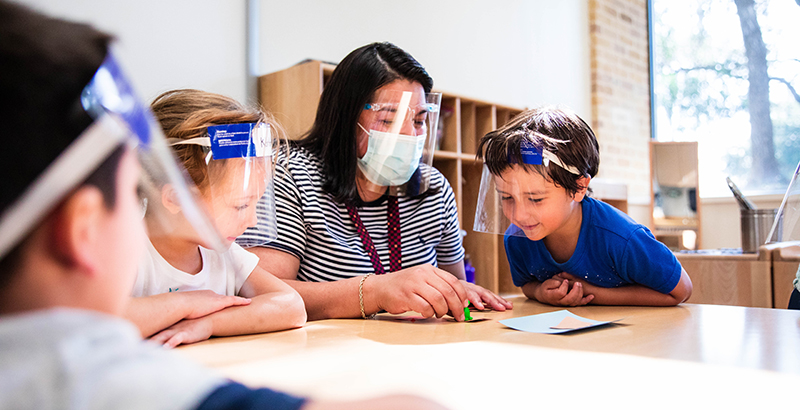One Year Ago, 90% of San Antonio’s 4-Year-Olds Were Enrolled in School: Now, an Ambitious Texas Early Ed Program is Crumbling Under the Weight of the Pandemic

This article was produced in partnership with The Texas Tribune.
For Sarah Baray, a dream seemed within reach as 2020 opened. More four-year-olds than ever before would spend at least part of their days in San Antonio classrooms, giggling and exploring with teachers skillfully guiding their play into crucial learning.
After four years as chief executive of an ambitious program to bring pre-K programs to San Antonio’s children, Baray saw it becoming an equalizer in the nation’s seventh largest city, just as she knew it could.
Ninety percent of San Antonio’s 25,000 4-year-olds were enrolled in pre-K at the beginning of the year – a pacesetting goal for Texas and the nation.
These joyful, creative classrooms were not just in exclusive private preschools and wealthy suburbs. They were all over the city — in neighborhoods where parents could not afford elite private schools, and in elementary schools where nearly every child qualified for free and reduced lunch.
Not only were more children being reached, but pre-K classrooms had been getting better. At private centers, teachers were learning new techniques to take play time and turn it into rich fodder for learning patience and patterns. Public schools were going from half-day programs to full-day, doubling the time for stories, play-dough numbers, yoga, and scissor skills.
Building the city’s network of public and private programs had been years of hard work, an epic fairytale of adventures and characters, all working together to make the city better for its youngest learners and their futures.

Then the book snapped shut in the middle of the story. As the coronavirus pandemic shuttered schools, the Pre-K 4 SA CEO could do little as she watched eight years of progress take a staggering step back.
As the pandemic stretched on, piece by piece, the system began to crumble.
Parents trying to work found that overseeing their childrens’ pre-K Zoom classes proved all but impossible. Remote learning didn’t work well for squirmy four-year-olds who needed constant monitoring and iPad help. Sitting in front of a screen is the opposite of the active, play-based learning they had been doing, and many parents worried it would do more harm than good.
Come fall, after a disastrous spring, many families shied away from remote pre-K. When schools did offer to take the kids back, many parents were afraid their children wouldn’t be able to abide the safety protocols, and would eventually bring the virus home.
The 2020 fall semester began with enrollment down by 30 percent across the city. Private schools lost tuition. Public schools were already fearing a loss of funding when the 2021 Legislature met to address a tight budget, and falling enrollment would not help.
But heaviest on Baray’s mind, she said, were the thousands of 4-year-olds who should be taking their first steps on a path toward academic and lifelong success.
“The immediate threat is real,” said Baray. “Children are only four once.”
Research over the last sixty years has shown that high quality pre-K helps students throughout their education and into adulthood. Strong curriculums like Montessori and High Scope help children develop executive function — the ability to regulate emotions, delay gratification, consider other perspectives, and more life skills that bolster future success.
Eight years ago, then-mayor Julián Castro asked San Antonio voters to offer those advantages to every 4-year-old in the city.
Voters approved a 2012 ballot measure providing $36 million per year for the initiative, and created Baray’s position, a ringmaster of sorts to assess and support public and private pre-K providers across the city, moving everyone toward the goal.
In addition to four learning centers it operates with city funding, Pre-K 4 SA puts $4.2 million per year into school districts and private childcare centers to help them offer full-day programs and strong curriculum. To strengthen the skills and credentials of the city’s early childhood teaching force, Pre-K 4 SA offers 10,000 hours of coaching and seminars each year.
Pre-K got another big boost when the 2019 Legislature gave districts money to expand their programs from half-day to full-day. Soon every student who qualified for state-funded pre-K would have access to it.
With that expansion, Baray was hopeful that Pre-K 4 SA would move into its next phase, with programs for families with any budget. The Pre-K 4 SA centers would serve the students whose families made too much money to qualify for public pre-K, but not enough money to pay for tuition at a private school. Pre-K 4 SA grants would continue going to any program looking to improve or expand something that was working.
Making the city’s program bigger and stronger was the pitch Baray was making to voters ahead of a municipal election in May 2020, when Pre-K 4 SA was up for its first ever renewal. She hoped to showcase what she saw as money well-spent.
But that election was cancelled because of the pandemic, putting Pre-K 4 SA on the November ballot along with other city tax initiatives.
With the election suddenly postponed, the most immediate crisis became the survival of private daycares and preschools, which had been serving 24 percent of the city’s 4-year-olds.
So far 28 private pre-K centers have closed in San Antonio — out of over 400 — and many more are struggling.
“The childcare industry and whether it’s going to recover from this is the big question mark,” Baray said.
Efforts to keep private centers afloat have mostly been insufficient. Texas used federal stimulus funds to make up for lost enrollment, but it wasn’t enough to make ends meet. The Texas Workforce Commission helped essential workers pay for childcare early in the pandemic, but that assistance ended in June.
For day care owners like Veronica Islas that meant a devastating summer.
She held out for as long as she could before closing the doors to Night Owl Child Care Centers, a preschool known for its good teachers and programs in a low income pocket of northeast San Antonio. Enrollment dropped from around 100 before the pandemic to 17 infants and children. She had to lay off all but six of her 30 employees.
“We thought that when school started parents were going to take the kids back to the daycare, but that didn’t happen,” said Islas. In September she closed the doors at Night Owl, hoping to save what money she can and to reopen the center at some point.
By September public schools, which serve 58 percent of pre-K students, could see their own funding crisis on the horizon. The largest districts in San Antonio lost between 30 and 50 percent of their pre-K enrollment. Each seat lost equates to lost revenue.
Chelsea Polanco unenrolled her 4-year-old daughter from Northside ISD after she tried remote learning. Balancing it with her work-from-home schedule was impossible, said Polanco, a teacher working remotely. She couldn’t always oversee her daughter’s Zoom lessons or pick up supplies from the school. “It’s not really do-able when I have to work until five.”
She’s homeschooling her daughter now to make sure she doesn’t miss out on the benefits of pre-K. Managing the curriculum herself, Polanco has been able to both homeschool and work, and her daughter is thriving. “She’s actually ahead,” Polanco said.
Given that the huge dip in enrollment is entirely pandemic-related, superintendents are asking for the state to base their funding for the next two school years on their attendance during the 2019-20 school year. So far the state has agreed to disregard the fall attendance, a “hold harmless” provision, but no such promises have been made for the spring semester.
The economic recession caused by the pandemic coincided with plummeting tax collections on oil. That is fueling an expected state budget shortfall. This summer, that projected revenue shortfall was $4.6 billion. Comptroller Glenn Hegar said in November the shortfall in the current state budget won’t be that bad, but he hasn’t provided details. He’s expected to unveil the state’s project spending limits next week.
This has pre-K advocates worried about what might be on the chopping block when the Legislature convenes to set a biennial budget for public schools. Pre-K funding “is on the table,” Baray said. “There are hard choices to be made. That’s real.”
Two years ago, Texas’s House Bill 3 added $11.6 billion to public schools. It included the Early Education Allotment, a pot of money districts can use to expand high quality pre-K.
Houston-area Republican and Chair of the House Public Education Committee Rep. Dan Huberty said the will does not exist to go back on the funding gains made in 2019. “The commitment is still there,” Huberty said.
State Rep. Diego Bernal, a San Antonio Democrat, agreed that the allotment should be safe. “I think that there is a consensus that we should do the best we can to draw a halo around public education to avoid cuts.”
Pre-K advocates likely won’t exhale until the budget is signed. “We have to make the case,” Baray said.
In the meantime, she said, it’s critical to do what can be done for this year’s 4-year-olds.
“Pandemic or no pandemic, children’s brains are developing very rapidly,” Baray said.
As the school year began Pre-K 4 SA learning centers, which only serve 8 percent of San Antonio 4-year-olds, reported an enrollment decline of around 25 percent. The four Pre-K 4 SA Centers were operating at about half their capacity for in-person learning, with around 500 students in remote learning.
The lost enrollment wouldn’t affect the program’s funding, which hinged on the rapidly-approaching November election. Their main challenge was to try to ensure that students were getting the quality they needed.
Pre-K 4 SA staff taught parents and other caregivers how to log kids on to remote-learning programs, and sent books and supplies to students’ homes to keep kids learning.
Nora Alejo has taken full advantage of the materials and training Pre-K 4 SA has offered, as she works with her son, Arturo, 4, who is learning remotely.
Their highly structured day begins at 7:30 am, working through the pre-recorded lessons, logging on for zoom calls. They send in their “book talk” recordings—Alejo videos Arturo answering questions about a book the class has read, usually focused on social and emotional learning— to Arturo’s pre-K teacher, who always gives individualized feedback telling Alejo what she’s noticing about Arturo’s progress.
“I’m learning a lot about how to teach my kid,” Alejo said.
In November, Baray got her first piece of undeniably good news since the pandemic began. Voters renewed Pre-K 4 SA this November, with 73 percent voting in favor. The vote secured the initiative’s funding, which will also allow the program to keep supporting private and district programs as they weather the pandemic.
“San Antonio is actually much better positioned than some other cities because we have Pre-K 4 SA,” Baray said. She’s hoping the three sectors will be able to provide enough seats for the next group of San Antonio preschoolers ready to enroll.
And they will be, she said. One of the cornerstones of Pre-K 4 SA was a public awareness campaign to help every family see the importance of pre-K and early learning. That message hasn’t been forgotten, she said. She’s confident that whatever impossible choices they faced during the pandemic, San Antonio families will be back in force when the pandemic subsides.
“In San Antonio,” said Baray, “families want their children in pre-K.”
Get stories like these delivered straight to your inbox. Sign up for The 74 Newsletter

;)
